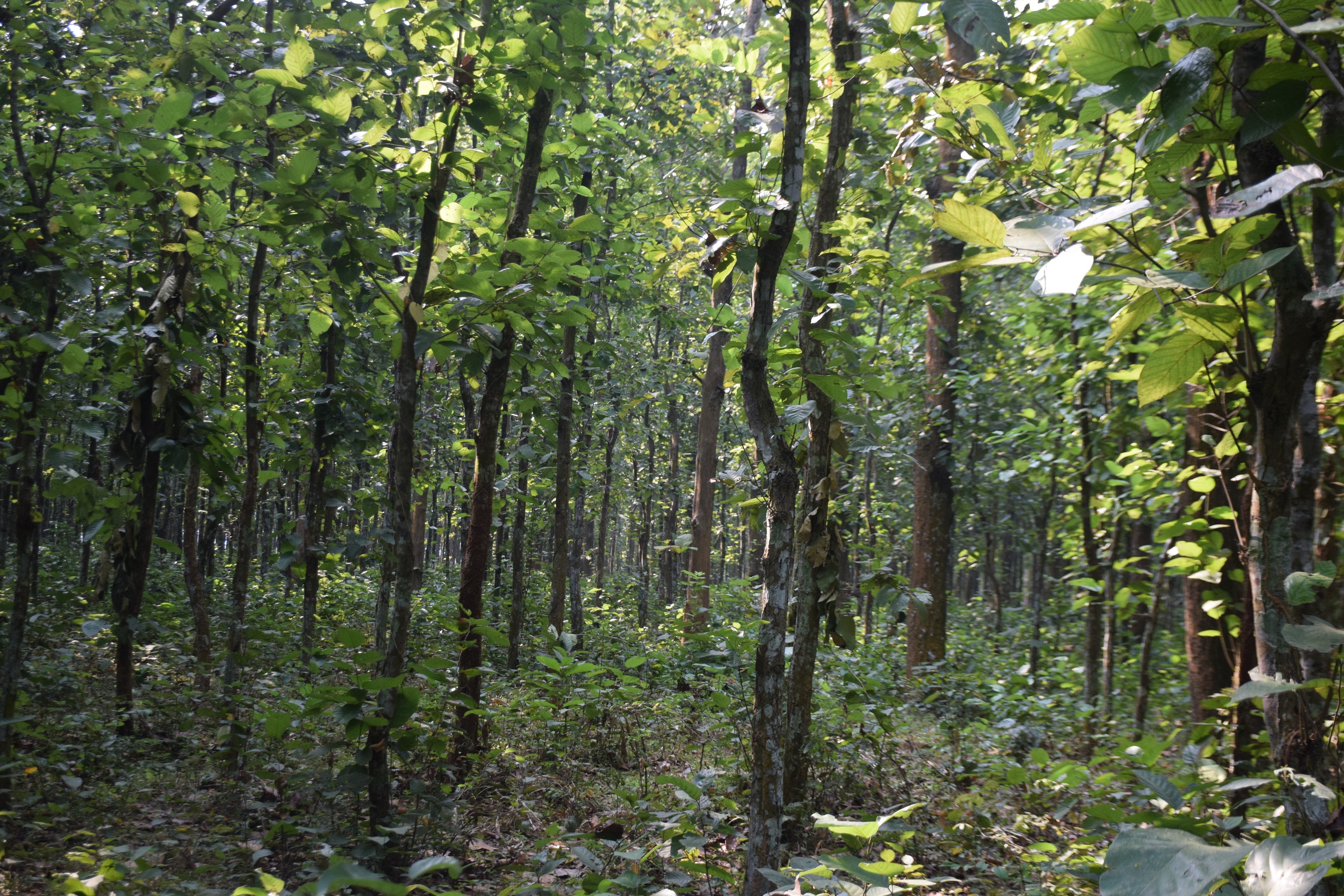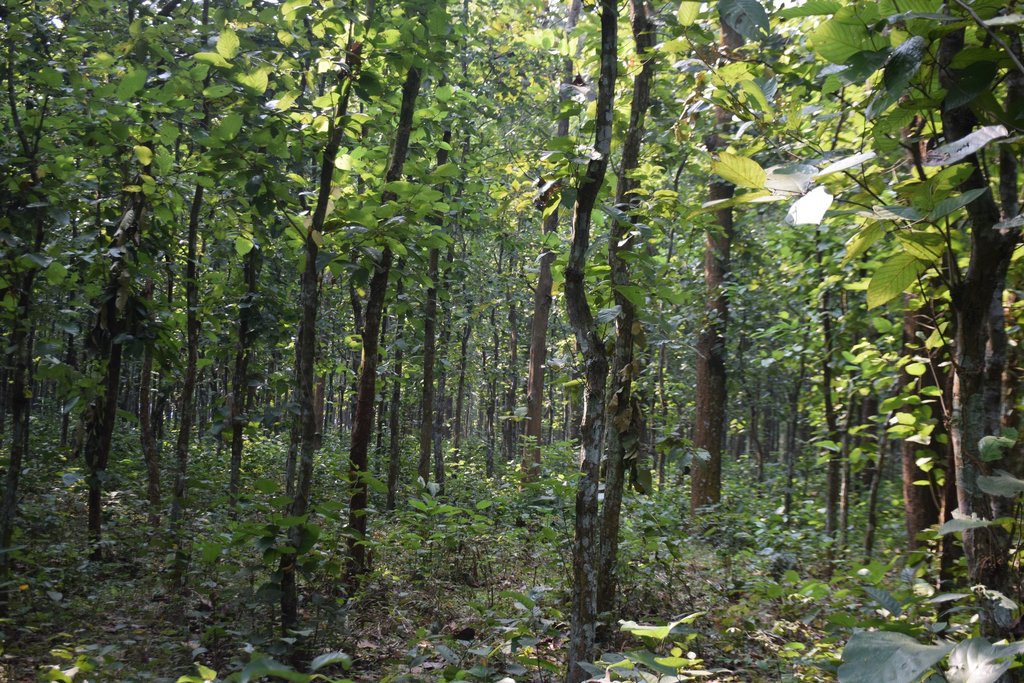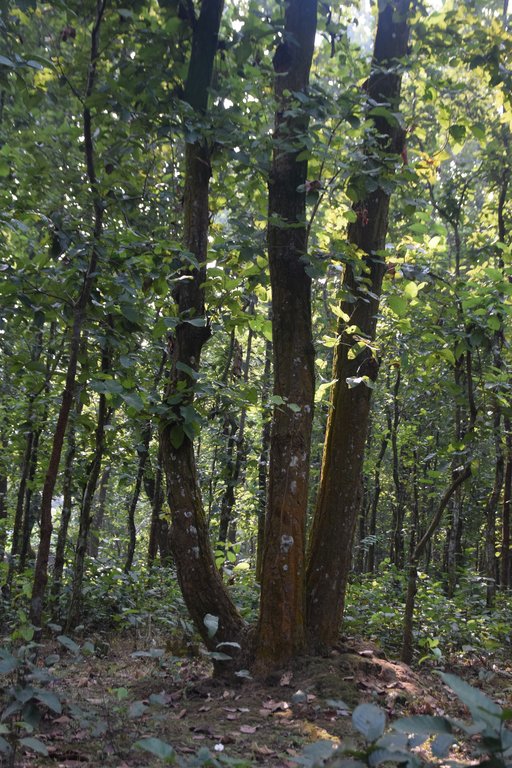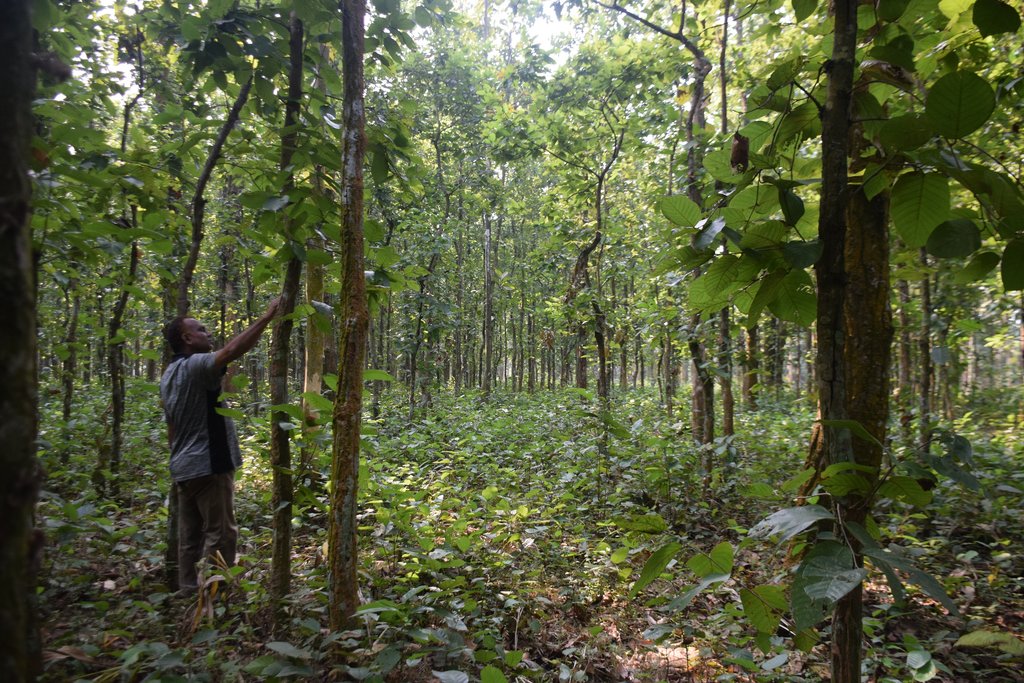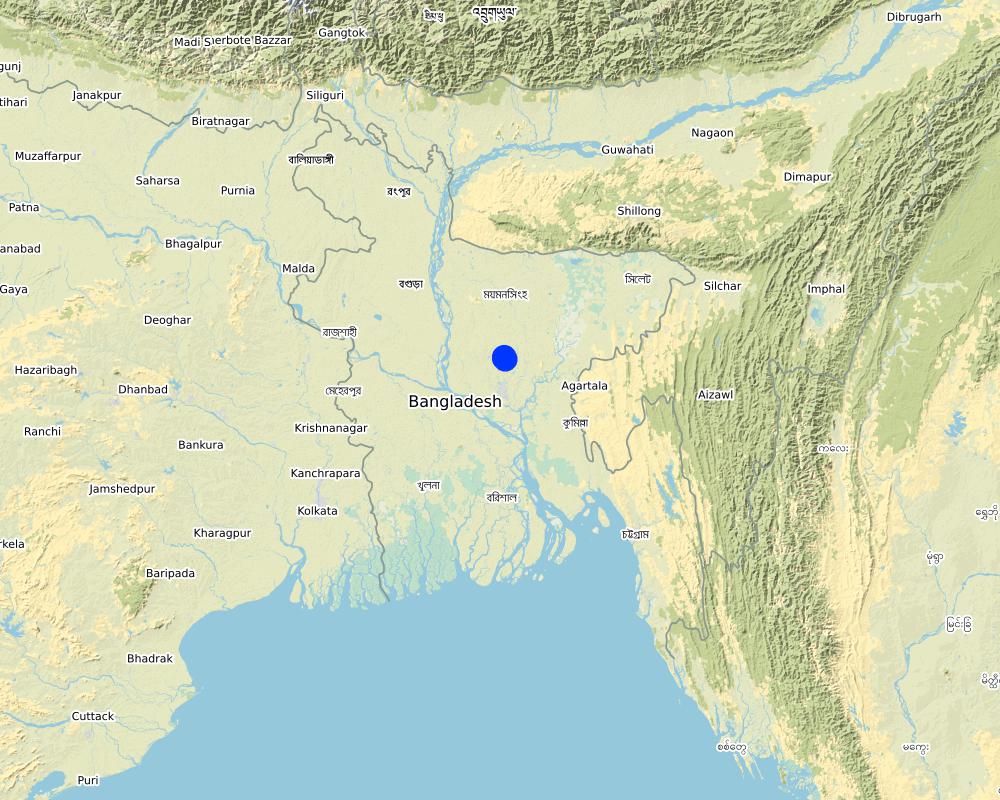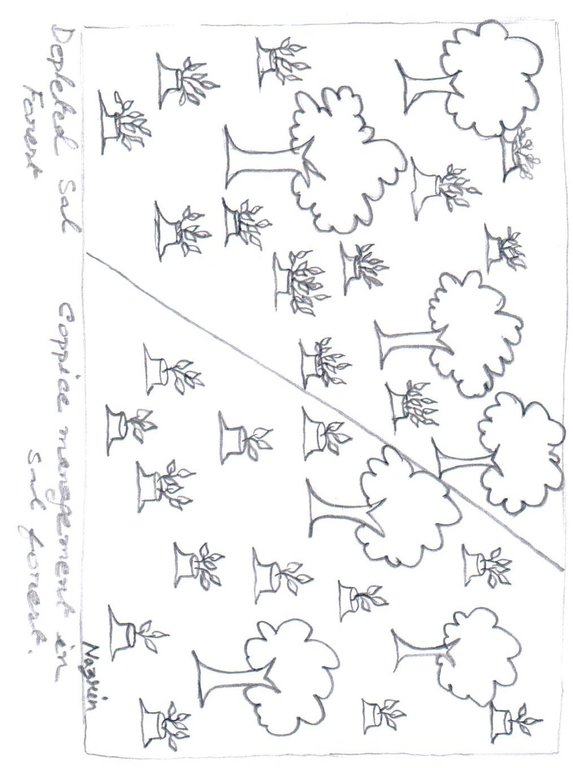Coppice management of Sal (Shorea robusta) forest [Bangladesh]
- Criação:
- Atualização:
- Compilador/a: Fazlay Arafat
- Editor: –
- Revisores: Rima Mekdaschi Studer, Ursula Gaemperli
Sal bon bebosthapona
technologies_4830 - Bangladesh
Veja as seções
Expandir tudo Recolher tudo1. Informação geral
1.2 Detalhes do contato das pessoas capacitadas e instituições envolvidas na avaliação e documentação da tecnologia
Pessoa(s) capacitada(s)
Especialista em GST:
Mohammed Nur
Bangladesh Forest Department
Bangladesh
usuário de terra:
Abedin Md. Joynal
Bangladesh
usuário de terra:
Rahman Md. Mojibur
Bangladesh
Nome do projeto que facilitou a documentação/avaliação da Tecnologia (se relevante)
Decision Support for Mainstreaming and Scaling out Sustainable Land Management (GEF-FAO / DS-SLM)Nome da(s) instituição(ões) que facilitou(ram) a documentação/ avaliação da Tecnologia (se relevante)
Bangladesh Forest Department (Bangladesh Forest Department) - Bangladesh1.3 Condições em relação ao uso da informação documentada através de WOCAT
O/a compilador/a e a(s) pessoa(s) capacitada(s) aceitam as condições relativas ao uso de dados documentados através da WOCAT:
Sim
1.4 Declaração de sustentabilidade da tecnologia descrita
A tecnologia descrita aqui é problemática em relação a degradação da terra de forma que não pode ser declarada uma tecnologia de gestão sustentável de terra?
Não
2. Descrição da tecnologia de GST
2.1 Descrição curta da tecnologia
Definição da tecnologia:
The coppice management of Sal (Shorea robusta) tree is a forest management practice to regain the natural forest resources in central and northern parts of Bangladesh.
2.2 Descrição detalhada da tecnologia
Descrição:
Sal forests have a fairly wide and interrupted distribution in the drier central and northern parts of the country. These tropical moist deciduous forests are popularly known as Sal forest as the predominant species is Sal (Shorea robusta). The importance of Sal forests lies in the fact that these are the only natural forest resources of the central and northern parts of Bangladesh where the majority of the country’s population lives. Historically, the agrarian rural people around the forests have been heavily dependent on Sal forests for their livelihood. Until the beginning of the 20th century, Sal forests existed as a large continuous belt with rich biological resources but increasing pressure from population growth has been placed on them ever since. Most of the Sal forests have either become degraded in quality or reduces by conversion to agricultural land.
The Forest Department introduced coppice management with natural regeneration in Sal forest that have a rotation of 20-30 years to regain the forest structure and biomass. Coppicing is a traditional method of forest management, which exploits the capacity of tree species to put out new shoots from their stump or roots if cut down. Due to the fact that shoots perform better than seedlings, because they obtain water, nutrients and carbohydrates from a well-developed root system of the parent tree, they are more resilient to human disturbances that affect tree growth and survival. As new growth emerges after a number of years, the coppiced tree is harvested, and the cycle begins again. Therefore, coppicing is considered an efficient mechanism by which trees regain above-ground biomass immediately after disturbance.
The Gazipur Sal forest is located in lowland plain areas of the central parts of Bangladesh. The average temperature in Gazipur is 25.8 °C and the annual rainfall is 2036 mm. The area is densely populated with a population density of 2,505 per square km. The dominant land use is still agriculture, but industrialization rate is higher in the area as it is only 25km away from capital Dhaka. The Sal forest area is managed by Bangladesh Forest division. Co-management approach is introduced in some buffer areas for the coppice management of Shorea robusta with a profit-sharing ratio of 65:25 between forest department and community beneficiaries. The rest of 10% money allocated for further tree farming activities.
No new planting of Sal seedlings is necessary for this practice. In the first year a relatively poor-quality Sal stand of Gazipur site were selected where coppice regeneration took place from stumps. Then, the multiple shoots regenerated from the stump were singled to three best shoots per stump and the rest were harvested. These three shoots were maintained in the following years and new shoots were removed if there were any. In addition, regular weeding was needed to maintain the technology. Local community people engaged to the maintenance and surveillance activities through co-management modalities and they will get their profit share after harvesting of the mature stand.
Where the density of Sal stumps is between 200-400 stems/ha, coppice management potentially protects and promotes the growth of new Sal seedling and other natural species in open areas. The native species regeneration under coppice management helps protect biodiversity value in a cost-effective manner. Coppice Sal Forests have the capacity to regenerate a rich variety of Non-Timber Forest Products (NTFPs). The major NTFPs collected by the co-management beneficiaries include fuelwood, dry leaves for fuel, and medicinal plants. Apart from this, they also collect mushroom, tuber crops, wild fruits, cane, honey and resin from coppice forests. As the area is under permanently protected area the beneficiaries cannot harvest any timber from the stand.
As the artificial regeneration of Sal is difficult, the sustainable forest management can be ensured through coppice management of Sal. In Gazipur, the depleted Sal forest are now slowly regaining its health and habitats for wildlife are improving as well. These forests, which historically were seen as timber sources, are now managed for multiple products through coppice management. The forest now supports alternate income for community people and also playing important role for ecological balance of this region.
2.3 Fotos da tecnologia
2.5 País/região/locais onde a tecnologia foi aplicada e que estão cobertos nesta avaliação
País:
Bangladesh
Região/Estado/Província:
Dhaka division
Especificação adicional de localização:
Gazipur
Especifique a difusão da tecnologia:
- Uniformemente difundida numa área
Se a área precisa não for conhecida, indicar a área aproximada coberta:
- 10-100 km2
O(s) local(is) tecnológico(s) está(ão) localizado(s) em uma área permanentemente protegida?
Sim
Caso afirmativo, especifique:
The Gazipur Sal forest is located in a permanent protected area where local communities cannot collect any timber other than fuel wood and NTFP
Map
×2.6 Data da implementação
Caso o ano exato seja desconhecido, indique a data aproximada:
- 10-50 anos atrás
2.7 Introdução da tecnologia
Especifique como a tecnologia foi introduzida:
- Como parte do sistema tradicional (>50 anos)
3. Classificação da tecnologia de GST
3.1 Principal/principais finalidade(s) da tecnologia
- Melhora a produção
- Reduz, previne, recupera a degradação do solo
- Preserva ecossistema
- Criar impacto econômico benéfico
- Cria impacto social benéfico
3.2 Tipo(s) atualizado(s) de uso da terra onde a tecnologia foi aplicada
Uso do solo misturado dentro da mesma unidade de terra:
Não

Floresta/bosques
- Florestas/bosques (semi)naturais
Florestas (semi)naturais/ bosques: Especificar o tipo de manejo:
- Retirada de madeira morta/podas
Tipo de floresta (semi)natural:
- vegetação natural de floresta tropical úmida de folha caduca
- Shorea robusta; Terminalia bellirica; Phyllanthus emblica; Albizia saman
As árvores especificadas acima são decíduas ou perenes?
- decíduas mistas/perene
Produtos e serviços:
- Madeira
- Lenha
- Frutas e nozes
- Outros produtos florestais
- Conservação/proteção da natureza
- Lazer/turismo
3.3 O uso do solo mudou devido à implementação da Tecnologia?
O uso do solo mudou devido à implementação da Tecnologia?
- Não (Continuar com a pergunta 3.4)
Comentários:
The original Sal forest stand faced rapid reduction through over-exploitation, deforestation, excessive leaf-litter collection, encroachment, indiscriminate collection of specific economically important plant species (i.e medicinal, fodder etc), and other form of human interference. This was degraded forest with some scatter trees.
3.4 Abastecimento de água
Abastecimento de água para a terra na qual a tecnologia é aplicada:
- Precipitação natural
3.5 Grupo de GST ao qual pertence a tecnologia
- Gestão natural e seminatural de floresta
- Gestão de plantação florestal
- Solo/cobertura vegetal melhorada
3.6 Medidas de GST contendo a tecnologia

Medidas vegetativas
- V1: cobertura de árvores/arbustos

Medidas de gestão
- M2: Mudança de gestão/nível de intensidade
3.7 Principais tipos de degradação da terra abordados pela tecnologia

Erosão do solo pela água
- Wt: Perda do solo superficial/erosão de superfície

Erosão do solo pelo vento
- Et: Perda do solo superficial

Degradação biológica
- Bc: redução da cobertura vegetal
- Bh: perda dos habitats
- Bq: quantidade/ declínio da biomassa
- Bs: Qualidade e composição de espécies/declínio de diversidade
- Bl: perda da vida do solo
3.8 Redução, prevenção ou recuperação da degradação do solo
Especifique o objetivo da tecnologia em relação a degradação da terra:
- Reduzir a degradação do solo
4. Especificações técnicas, implementação de atividades, entradas e custos
4.1 Desenho técnico da tecnologia
Especificações técnicas (relacionada ao desenho técnico):
The left hand of the picture represents a depleted Sal forest where only few trees remain and multiple shoots regenerated from the stumps of chopped down Sal trees. The right hand of the picture shows the coppice management in the depleted forest stand. From the regenerated multiple shoots of only one to three best shoots per stump are allowed to grow and other shoots removed. These three shoots were maintained in the following years and new shoots were removed if there were any.
Autor:
Nazrin Sultana
Data:
20/05/2019
4.2 Informação geral em relação ao cálculo de entradas e custos
Especifique como custos e entradas foram calculados:
- por área de tecnologia
Indique o tamanho e a unidade de área:
1 ha
Se utilizar uma unidade de área local, indicar fator de conversão para um hectare (por exemplo, 1 ha = 2,47 acres): 1 ha =:
2.47 acres
Outro/moeda nacional (especifique):
BDT
Se for relevante, indique a taxa de câmbio do USD para moeda local (por exemplo, 1 USD = 79,9 Real): 1 USD =:
84,0
Indique a média salarial da mão-de-obra contratada por dia:
500 BDT
4.3 Atividades de implantação
| Atividade | Periodicidade (estação do ano) | |
|---|---|---|
| 1. | Site preparation (prepare plantation site map with GPS, jungle cutting, debris collection) | June-July |
| 2. | Thinning (removal of unwanted shoots from stumps) | June-July |
| 3. | Application of fertilizer (compost) | July |
4.4 Custos e entradas necessárias para a implantação
| Especifique a entrada | Unidade | Quantidade | Custos por unidade | Custos totais por entrada | % dos custos arcados pelos usuários da terra | |
|---|---|---|---|---|---|---|
| Mão-de-obra | Site preparation (prepare plantation site map with GPS, jungle cutting, debris collection) | person-days | 5,0 | 500,0 | 2500,0 | 100,0 |
| Mão-de-obra | Thinning (removal of unwanted shoots from stumps) | person-days | 12,0 | 500,0 | 6000,0 | 100,0 |
| Mão-de-obra | Application of fertilizer | person-days | 5,0 | 500,0 | 2500,0 | 100,0 |
| Equipamento | Spade, saw, bucket, knife, etc. | lump sum | 1,0 | 2000,0 | 2000,0 | 100,0 |
| Fertilizantes e biocidas | Compost fertilizer | kg | 2000,0 | 4,0 | 8000,0 | 100,0 |
| Custos totais para a implantação da tecnologia | 21000,0 | |||||
| Custos totais para o estabelecimento da Tecnologia em USD | 250,0 | |||||
Comentários:
Bangladesh Forest Department is the land owner and bear the cost of this practice
4.5 Atividades recorrentes/manutenção
| Atividade | Periodicidade/frequência | |
|---|---|---|
| 1. | 1st year weeding | 3 times |
| 2. | 2nd year weeding | 3 times |
| 3. | 3rd year weeding | 2 times |
| 4. | 4th year weeding | 1 time |
4.6 Custos e entradas necessárias pata a manutenção/atividades recorrentes (por ano)
| Especifique a entrada | Unidade | Quantidade | Custos por unidade | Custos totais por entrada | % dos custos arcados pelos usuários da terra | |
|---|---|---|---|---|---|---|
| Mão-de-obra | 1st year weeding | person-days | 12,0 | 500,0 | 6000,0 | 100,0 |
| Mão-de-obra | 2nd year weeding | person-days | 12,0 | 500,0 | 6000,0 | 100,0 |
| Mão-de-obra | 3rd year weeding | person-days | 8,0 | 500,0 | 4000,0 | 100,0 |
| Mão-de-obra | 4th year weeding | person-days | 4,0 | 500,0 | 2000,0 | 100,0 |
| Equipamento | Spade, saw, bucket, knife, etc. | Lump-sum | 1,0 | 2000,0 | 2000,0 | 100,0 |
| Custos totais para a manutenção da tecnologia | 20000,0 | |||||
| Custos totais de manutenção da Tecnologia em USD | 238,1 | |||||
4.7 Fatores mais importantes que afetam os custos
Descreva os fatores mais determinantes que afetam os custos:
Labor cost
5. Ambiente natural e humano
5.1 Clima
Precipitação pluviométrica anual
- <250 mm
- 251-500 mm
- 501-750 mm
- 751-1.000 mm
- 1.001-1.500 mm
- 1.501-2.000 mm
- 2.001-3.000 mm
- 3.001-4.000 mm
- > 4.000 mm
Zona agroclimática
- Subúmido
5.2 Topografia
Declividade média:
- Plano (0-2%)
- Suave ondulado (3-5%)
- Ondulado (6-10%)
- Moderadamente ondulado (11-15%)
- Forte ondulado (16-30%)
- Montanhoso (31-60%)
- Escarpado (>60%)
Formas de relevo:
- Planalto/planície
- Cumes
- Encosta de serra
- Encosta de morro
- Sopés
- Fundos de vale
Zona de altitude:
- 0-100 m s.n.m.
- 101-500 m s.n.m.
- 501-1.000 m s.n.m.
- 1.001-1.500 m s.n.m.
- 1.501-2.000 m s.n.m.
- 2.001-2.500 m s.n.m.
- 2.501-3.000 m s.n.m.
- 3.001-4.000 m s.n.m.
- > 4.000 m s.n.m.
Indique se a tecnologia é aplicada especificamente em:
- Não relevante
5.3 Solos
Profundidade do solo em média:
- Muito raso (0-20 cm)
- Raso (21-50 cm)
- Moderadamente profundo (51-80 cm)
- Profundo (81-120 cm)
- Muito profundo (>120 cm)
Textura do solo (solo superficial):
- Fino/pesado (argila)
Textura do solo (>20 cm abaixo da superfície):
- Fino/pesado (argila)
Matéria orgânica do solo superficial:
- Alto (>3%)
5.4 Disponibilidade e qualidade de água
Lençol freático:
5-50 m
Disponibilidade de água de superfície:
Médio
Qualidade da água (não tratada):
apenas para uso agrícola (irrigação)
A qualidade da água refere-se a:
água de superfície
A salinidade da água é um problema?
Não
Ocorre inundação da área?
Não
5.5 Biodiversidade
Diversidade de espécies:
- Médio
Diversidade de habitat:
- Médio
5.6 Características dos usuários da terra que utilizam a tecnologia
Sedentário ou nômade:
- Sedentário
Orientação de mercado do sistema de produção:
- misto (subsistência/comercial)
Rendimento não agrícola:
- 10-50% de toda renda
Nível relativo de riqueza:
- Média
Indivíduos ou grupos:
- Empregado (empresa, governo)
Nível de mecanização:
- Trabalho manual
Gênero:
- Mulheres
- Homens
Idade dos usuários da terra:
- Jovens
- meia-idade
- idosos
5.7 Área média de terrenos utilizados pelos usuários de terrenos que aplicam a Tecnologia
- < 0,5 ha
- 0,5-1 ha
- 1-2 ha
- 2-5 ha
- 5-15 ha
- 15-50 ha
- 50-100 ha
- 100-500 ha
- 500-1.000 ha
- 1.000-10.000 ha
- > 10.000 ha
É considerado pequena, média ou grande escala (referente ao contexto local)?
- Média escala
5.8 Propriedade de terra, direitos de uso da terra e de uso da água
Propriedade da terra:
- Estado
Direitos do uso da terra:
- Comunitário (organizado)
Direitos do uso da água:
- Acesso livre (não organizado)
Os direitos de uso da terra são baseados em um sistema jurídico tradicional?
Não
Especifique:
Participatory forest management in coppice Sal forest with local commuities
5.9 Acesso a serviços e infraestrutura
Saúde:
- Pobre
- Moderado
- Bom
Educação:
- Pobre
- Moderado
- Bom
Assistência técnica:
- Pobre
- Moderado
- Bom
Emprego (p. ex. não agrícola):
- Pobre
- Moderado
- Bom
Mercados:
- Pobre
- Moderado
- Bom
Energia:
- Pobre
- Moderado
- Bom
Vias e transporte:
- Pobre
- Moderado
- Bom
Água potável e saneamento:
- Pobre
- Moderado
- Bom
Serviços financeiros:
- Pobre
- Moderado
- Bom
6. Impactos e declarações finais
6.1 Impactos no local mostrados pela tecnologia
Impactos socioeconômicos
Produção
Produção de madeira
Qualidade da floresta/do bosque
Produção florestal não madeireira
Risco de falha de produção
Diversidade de produtos
Comentários/especificar:
Some agroforestry products also derived from the practice of local communities
Renda e custos
Diversidade de fontes de rendimento
Impactos socioculturais
Direitos do uso da terra/à água
Comentários/especificar:
re-establishment of Sal forest through coppice management with involving local community allowed them to collect NTFP from the forest
Oportunidades culturais
Oportunidades de lazer
Comentários/especificar:
Ecotourism has benn promoted in the area
Instituições comunitárias
Comentários/especificar:
Through co-management of Sal forest the local community institutions strengthened
Conhecimento de GST/ degradação da terra
Comentários/especificar:
The scattered degraded forest is now managed in a sustainable manner
Atenuação de conflitos
Comentários/especificar:
Conflict on forest land use has been reduced due to co-management
Situação de grupos social e economicamente desfavorecidos
Comentários/especificar:
the extreme poor people who were depended on forest now are member of the co-management group under the profit sharing approach
Impactos ecológicos
Solo
Umidade do solo
Cobertura do solo
Perda de solo
Acumulação de solo
Compactação do solo
Ciclo e recarga de nutrientes
Matéria orgânica do solo/carbono abaixo do solo
Biodiversidade: vegetação, animais
Cobertura vegetal
Biomassa/carbono acima do solo
Diversidade vegetal
Espécies benéficas
Diversidade de habitat
Clima e redução de riscos de desastre
Emissão de carbono e gases de efeito estufa
Velocidade do vento
Microclima
6.2 Impactos externos mostrados pela tecnologia
Disponibilidade de água
Comentários/especificar:
groundwater aquifer recharges due to presence of forest canopy cover
Capacidade de tamponamento/filtragem
Sedimentos transportados pelo vento
Impacto dos gases de efeito estufa
6.3 Exposição e sensibilidade da tecnologia às mudanças climáticas graduais e extremos/desastres relacionados ao clima (conforme o ponto de vista dos usuários da terra)
Mudança climática gradual
Mudança climática gradual
| Estação do ano | aumento ou diminuição | Como a tecnologia lida com isso? | |
|---|---|---|---|
| Temperatura anual | aumento | bem | |
| Temperatura sazonal | verão | aumento | bem |
| Precipitação pluviométrica anual | redução/diminuição | bem | |
| Precipitação pluviométrica sazonal | estação úmida/das chuvas | aumento | bem |
Extremos (desastres) relacionados ao clima
Desastres meteorológicos
| Como a tecnologia lida com isso? | |
|---|---|
| Temporal local | bem |
| Trovoada local | bem |
Desastres climatológicos
| Como a tecnologia lida com isso? | |
|---|---|
| Seca | moderadamente |
6.4 Análise do custo-benefício
Como os benefícios se comparam aos custos de implantação (do ponto de vista dos usuários da terra)?
Retornos a curto prazo:
levemente negativo
Retornos a longo prazo:
muito positivo
Como os benefícios se comparam aos custos recorrentes/de manutenção(do ponto de vista dos usuários da terra)?
Retornos a curto prazo:
levemente negativo
Retornos a longo prazo:
muito positivo
6.5 Adoção da tecnologia
- > 50%
De todos aqueles que adotaram a Tecnologia, quantos o fizeram espontaneamente, ou seja, sem receber nenhum incentivo/ pagamento material?
- 91-100%
Comentários:
Forest department adopted the technology and replicate it in other Sal forest area with co-management approach
6.6 Adaptação
A tecnologia foi recentemente modificada para adaptar-se as condições variáveis?
Não
6.7 Pontos fortes/vantagens/oportunidades da tecnologia
| Pontos fortes/vantagens/oportunidades na visão do usuário da terra |
|---|
| Establishment and maintenance costs arelow. |
| Artificial regeneration of Sal is difficult. Through coppice management forest coverage can be ensured for long period. |
| The population of the community can cover their fuel needs from the Sal forests. |
| Pontos fortes/vantagens/oportunidades na visão do/a compilador/a ou de outra pessoa capacitada |
|---|
| Increases the soil fertility of the degraded land through nutrient cycle. |
| Biodiversity conservation through habitat improvement. |
| Increase of carbon sequestration. |
6.8 Pontos fracos, desvantagens/riscos da tecnologia e formas de superá-los
| Pontos fracos/desvantagens/riscos na visão do usuário da terra | Como eles podem ser superados? |
|---|---|
| Protection from illicit felling of Sal is difficult. | Community people need to be engage in patrolling |
| Occurrence of fire in dry seasons hampered Sal coppice stand |
| Pontos fracos/vantagens/riscos na visão do/a compilador/a ou de outra pessoa capacitada | Como eles podem ser superados? |
|---|---|
| Timber yield from coppice stand of Sal is inferior in comparison with original stand of Sal. | Vacancy filling can be done with high value timber species |
7. Referências e links
7.1 Métodos/fontes de informação
- visitas de campo, pesquisas de campo
Number of informants: 5 persons
- entrevistas com usuários de terras
Number of informants: 4 persons
- entrevistas com especialistas em GST
Number of informants: 2 persons
- compilação de relatórios e outra documentação existente
Number of scientific articles: 3
Quando os dados foram compilados (no campo)?
20/11/2018
7.2 Referências às publicações disponíveis
Título, autor, ano, ISBN:
Islam KK, Sato N, 2012. Deforestation, land conversion and illegal logging in Bangladesh: the case of the Sal (Shorea robusta) forests. iForest 5: 171-178 [online 2012-06-25]
Disponível de onde? Custos?
http://www.sisef.it/iforest/contents? id=ifor0578-005
Título, autor, ano, ISBN:
Hossain, M.K. 2015. Silviculture of Plantaion Trees of Bangladesh, ISBN:978-984-33-9767-6
Disponível de onde? Custos?
Arannayk Foundation, Dhaka, Bangladesh. US$ 15
7.3 Links para informações on-line relevantes
Título/ descrição:
Joint Forest Management and Adaptation of Sal (Shorea robusta) and Its Flexibility in Wide Range of Ecological factors in Forest Gardens
URL:
http://ajast.net/data/uploads/5022.pdf
7.4 Comentários gerais
The questionnaire covers all the aspect of the practice
Links e módulos
Expandir tudo Recolher tudoLinks
Não há links
Módulos
Não há módulos


